|
1912
Charles Watson completes report outlining
vision for AUC
1919
AUC officially incorporated in
Washington, D.C.
1920
First 142 students begin classes equivalent to
the final two years of high school
Student Union formed
1921
School of Oriental Studies established
1923
First commencement
1924
Degrees recognized by the New York State
Board of Regents as equivalent to junior
college degrees
Division of Extension (forerunner to the
School of Continuing Education) established
First campus newspaper,
AUC Review, issued
1925
First university-level courses offered
Ruth Litt donated $100,000 for an
auditorium to be named after her
grandfather,William Dana Ewart
1926
Old Boys Club created for alumni
1927
AUC offers four years of secondary school
and four of college
1928
First university-level bachelor's degrees
awarded to three students
AUC welcomes first female student
Eva Habib el Masri
1929
Hill family started AUC's first endowment
fund with $450,000
1931
Old Boys Club developed into Alumni
Association
Gillespie family donated $65,000 to build
Oriental Hall
1937
Om Kalthum performed in Ewart Hall
Late
1930's
Campus Caravan replaced AUC Review
1940
King Abdullah of Jordan visited AUC
1941
AUC hosted special concerts in Ewart Hall for allied soldiers in Egypt
1942
AUC students petitioned Ministry of War to allow an instructor to teach them military formations, which soon replaced acrobatics
and team sports
1950
First graduate degree awarded
1951
Last preparatory class graduated, making AUC strictly a university-level institution
1952
Helen Keller visited AUC
1953
Hill House formally dedicated as first
student dormitory on campus
Social Research Center created
1954
Late Egyptian presidents Gamal Abdul
Nasser and Mohammed Naguib attended AUC’s Arabic Language Day Convocation
1956
English Language Institute opened
School of Oriental Studies became the
Center for Arabic Studies AUC obtained Creswell Collection
1959
Hill House rededicated as a library
1960
AUC Press established
1961
AUC’s name was changed from “at” Cairo to “in” Cairo
1964
Buildings purchased from the Greek
community. Falaki building built for use as a student dormitory
1966
Science Building construction completed
1967
Center for Arabic Study Abroad opened
Government sequestered AUC
1972
AUC Press obtained exclusive Englishlanguage
rights to the works of
Naguib Mahfouz
1974
Ministry of Higher Education recognized all but three AUC degrees as equivalent to those offered by Egyptian universities
Sports program won representation in the National Universities Sports Union
1975
Egyptian government relinquished control of AUC Protocol issued between AUC’s Board of Trustees and the Egyptian government
1978
AUC Press published the first Naguib
Mahfouz novel in English
1979
Desert Development Center approved
1982
New library on the Greek Campus
completed
AUC received largest single donation ($5,500,000) from Yousef Jameel ’68
Middle States Commission on Higher Education granted AUC full accreditation
1985
Opening of Egypt’s first university bookstore
1988
Mahfouz won Nobel Prize.AUC Press
was already his English-language publisher (with nine of his novels in print) and worldwide agent
1989
Abdul Latif Jameel Building for Middle
East Management Studies inaugurated
Core Curriculum introduced
Model United Nations started
1990
Model Arab League started
1991
AUC opened Zamalek building
1992
Rare books library inaugurated
1993
Noam Chomsky spoke at AUC
University Senate established
1994
AUC celebrated 75th anniversary
1995
Grand Mufti Sheikh Muhammed Tantawi
and Pope Shenouda III spoke at AUC
AUC Professor Kent Weeks rediscovered
KV5 in Valley of the Kings
1996
Naguib Mahfouz Medal for Literature
established
1997
AUC purchased land in New Cairo
1999
U.S. First Lady Hillary Clinton spoke in
Ewart Hall
2000
Queen Rania Al Abdullah ’91 visited
AUC. Distinguished guests in first years
of the century included Jimmy Carter, Kofi
Annan, Condoleezza Rice, and Nobel
laureates Ahmed Zewail and
Mohamed ElBaradei
2003
New Cairo Campus design completed and
cornerstone laid by Egypt’s First Lady
Suzanne Mubarak ’77, ’82
2004
AUC established Leadership for Education
and Development program
AUC signed construction contract for New
Cairo Campus
2007
AUC Press published its 1,000th book
2008
First day of class held on the New Cairo
Campus
2009
Egypt’s First Lady Suzanne Mubarak
’77, ’82 inaugurated New Cairo Campus
AUC celebrated 90th anniversary
|
|
DID YOU KNOW?
The AUC Pyramid
In the early 1920s,AUC was an allmale
school. Each student, dressed in
short pants and an undershirt, took two
hours of 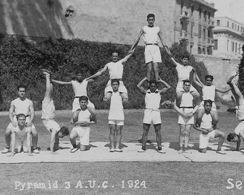 athletics each week, mainly
calisthenics and gymnastics. Back then,
people did not associate sports activities
with a college or university. In fact, some
connected physical activity with low
social status, while others were
embarrassed to be seen in short pants in public. Crowds often gathered
outside the AUC fence to watch. As the boys became more proficient,
they were able to form a pyramid by standing on each other’s
shoulders.This became an AUC landmark. athletics each week, mainly
calisthenics and gymnastics. Back then,
people did not associate sports activities
with a college or university. In fact, some
connected physical activity with low
social status, while others were
embarrassed to be seen in short pants in public. Crowds often gathered
outside the AUC fence to watch. As the boys became more proficient,
they were able to form a pyramid by standing on each other’s
shoulders.This became an AUC landmark.
Food Trivia
Cost of tuition in the 1920s was around LE 16 a year; compulsory
noon lunches cost LE 13.5 a year.The noon meal aimed to provide
a healthy time of companionship, allowing students to become
accustomed to Western food and giving teachers the opportunity to
introduce American table manners.
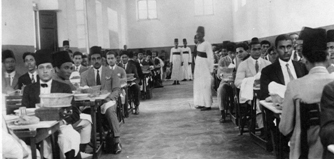
How Theater Began at AUC
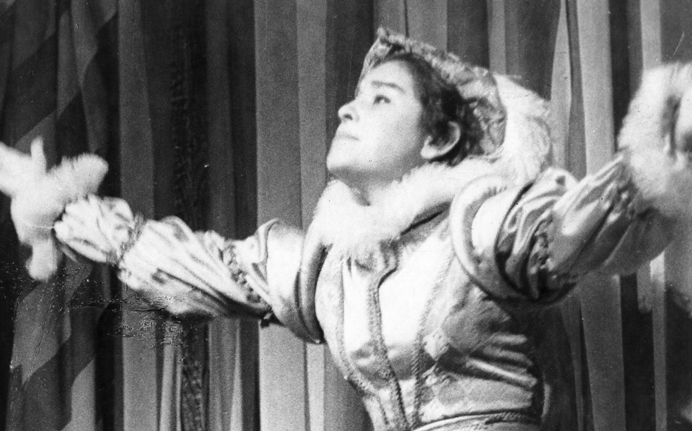 C.Worth Howard, head of the English department in the 1920s, emphasized dramatics as a means of self- expression and a way of improving English. Boys living in the hostel performed the first play in 1926, after which all students joined in presenting subsequent performances, with boys playing female roles when necessary.The theater program expanded, and plays were presented at assemblies, commencement ceremonies and for the general public. Students handled all aspects of production, from constructing the scenery and designing the costumes to distributing tickets. Howard was very popular among students, and his success led to the establishment of the College Players student club, which was later named the Masker's Club. C.Worth Howard, head of the English department in the 1920s, emphasized dramatics as a means of self- expression and a way of improving English. Boys living in the hostel performed the first play in 1926, after which all students joined in presenting subsequent performances, with boys playing female roles when necessary.The theater program expanded, and plays were presented at assemblies, commencement ceremonies and for the general public. Students handled all aspects of production, from constructing the scenery and designing the costumes to distributing tickets. Howard was very popular among students, and his success led to the establishment of the College Players student club, which was later named the Masker's Club.
Speak English on Campus
In AUC’s early years, there were “Speak English on Campus” campaigns. Desserts were awarded to those who used English
during the lunch hour, and a spelling bee encouraged competition among the best students.
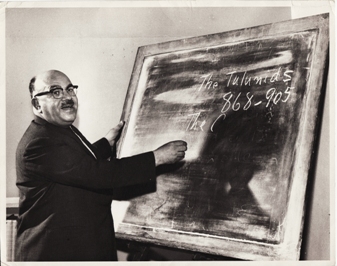
AUC's War Efforts
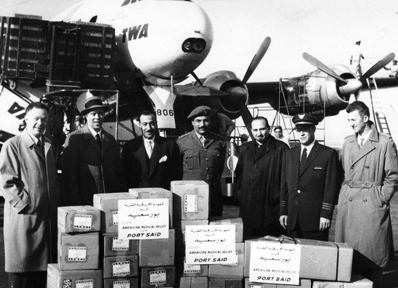 During World War II,AUC students petitioned the Ministry ofWar to allow an instructor to teach them military formations, which soon replaced acrobatics and team sports. The university also established a canteen for allied troops and offered special courses to them in Arabic and Egyptian culture.The Red Cross also used part of the athletic field, and the Allied Middle East Supply Center conducted experiments and tests in AUC's science laboratories. During the 1956 Suez War, AUC organized a blood donor's program to which Raymond McLain,AUC president at the time, made the first contribution, followed by members of the AUC community and the general public. During World War II,AUC students petitioned the Ministry ofWar to allow an instructor to teach them military formations, which soon replaced acrobatics and team sports. The university also established a canteen for allied troops and offered special courses to them in Arabic and Egyptian culture.The Red Cross also used part of the athletic field, and the Allied Middle East Supply Center conducted experiments and tests in AUC's science laboratories. During the 1956 Suez War, AUC organized a blood donor's program to which Raymond McLain,AUC president at the time, made the first contribution, followed by members of the AUC community and the general public.
A Tradition of Firsts
AUC was the first in the region to:
. Establish a university career center
. Launch an academic integrity initiative
. Hold the Model United Nations conference
. Offer a master's in international human rights law
. Establish a financial training and consulting center
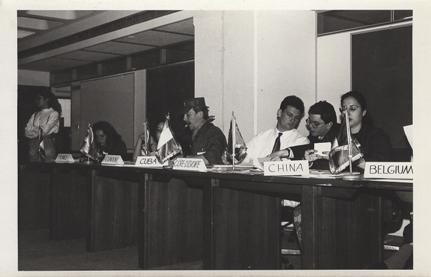
The Story Behind the Caravan
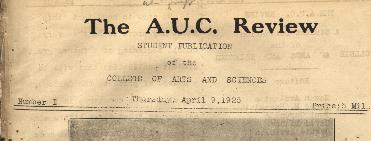 After several weeks After several weeks
of posting articles and pictures on a bulletin board, a journalism class issued the first newspaper, AUC Review, in April 1924. The four-page paper included articles on AUC personalities, campus news, official announcements and editorials on university issues. Gradually, outside advertising was secured, more students purchased subscriptions and the school contributed additional funds. As a result, bigger issues appeared each week. At the end of the year, a special issue focused on past activities and profiled graduating seniors.Within a year, an Arabic section was added. In the late 1930s, Campus Caravan replaced AUC Review, reporting on student activities and providing a workshop for journalism students.
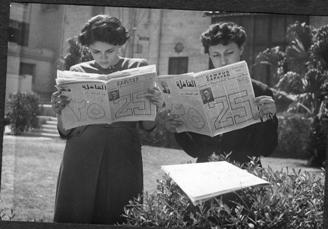
Grades on Personality
In the 1920s, students were graded on character traits such as obedience, diligence,
punctuality, cheerfulness,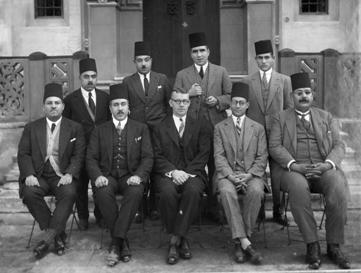
personal appearance,
honesty, initiative, generosity and companionship.The rating was made twice
a year.The purpose was to help students improve their personalities in preparation for success in life.
|